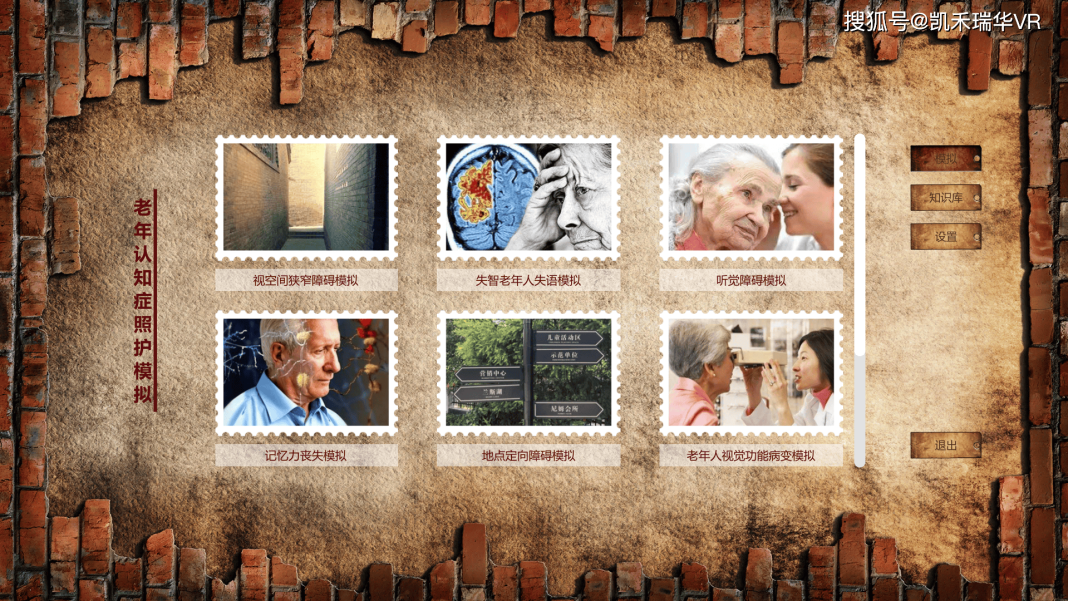With the acceleration of global population aging, elderly cognitive impairment, especially Alzheimer’s disease, has become a social issue that cannot be ignored. This poses a severe challenge to the medical system and also brings new requirements to medical education. From the perspective of higher vocational medical education, this article will delve into the background, implementation details, and the challenges and innovations posed to traditional teaching methods by the introduction of elderly cognitive impairment virtual simulation experiential training.
1. Application Prospects and Potential Benefits
Elderly cognitive impairment virtual simulation experiential training technology, as an emerging teaching method, has brought revolutionary changes to medical education. By simulating the daily life and work scenarios of elderly cognitive impairment patients, students can experience the psychological and physiological states of patients in a safe and controllable environment, gaining a deeper understanding of the impact of elderly cognitive impairment on patients and their families. This experiential learning not only enhances students’ empathy and communication skills but also nurtures their clinical thinking and decision-making abilities. Furthermore, the application of virtual simulation technology provides medical students with a risk-free practice platform, allowing them to practice operations in a simulated clinical environment, which is crucial for improving students’ practical skills and their ability to deal with real clinical situations.
2. Issues to Consider During Implementation
Several key issues need attention during the implementation of elderly cognitive impairment virtual simulation experiential training:
1. Cost-effectiveness analysis: Although the development and maintenance costs of virtual simulation technology are high, the long-term educational returns are evident. Higher vocational schools need to conduct detailed cost-effectiveness analyses to ensure that investments yield the expected educational outcomes.
2. Student acceptance: The introduction of new technology requires students’ active participation and acceptance. Schools should raise students’ awareness and interest in elderly cognitive impairment virtual simulation experiential training through promotion, education, and training.
3. Teacher training and professional development: Teachers are drivers of educational innovation. Higher vocational schools should provide professional training and support to teachers to enable them to master virtual simulation technology and effectively integrate it into teaching.
4. Technology updates and maintenance: With rapid technological advancements, virtual simulation systems require regular updates and maintenance to ensure the modernity and relevance of their educational content and functionality.
3. Impact on Higher Vocational School Education Models
1. Enhancement of practical abilities: Through elderly cognitive impairment virtual simulation experiential training, students can practice operations in a simulated environment, helping improve their clinical skills and problem-solving abilities.
2. Strengthening of employment competitiveness: Students with virtual simulation experiential training experience can demonstrate stronger practical skills and innovative thinking during job applications, thereby enhancing their competitiveness in the medical industry.
3. Innovation in education models: The introduction of elderly cognitive impairment virtual simulation experiential training will drive higher vocational school education models towards greater personalization, interactivity, and practicality, providing students with richer and more diverse learning experiences.
4. Cultivation of social responsibility: By experiencing the lives of elderly cognitive impairment patients, students can gain a deeper understanding of the needs and challenges of the elderly population, fostering their sense of social responsibility and service awareness.
Conclusion
The introduction of elderly cognitive impairment virtual simulation experiential training is not only a significant innovation in higher vocational medical education models but also a profound challenge to traditional teaching methods. Through this innovative teaching approach, higher vocational schools can cultivate professional medical and nursing talents who are more empathetic and better able to understand patient needs, making a positive contribution to addressing the challenges posed by population aging. At the same time, this sets a new development path for higher vocational education, signaling that future educational models will focus more on cultivating practical skills and stimulating innovative thinking.


